| |
| |
Photographer,
Location |
Images |
Comments |
|
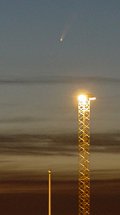
|
Veli
Matti Pelttari,
Rovaniemi, Finland
Jan. 6, 2007 |
#1 |
Photo
details: Sony
Cybershot DSC-F717, f/2.4, ISO 100, 1 sec |
|
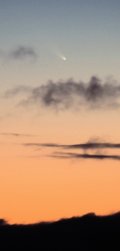
|
Christopher
Stevenson,
Signal Hill, St. John's, Newfoundland, Canada
Jan. 8, 2007 |
#1 |
After
several attempts aborted due to poor weather, finally some
luck at 7:00 A.M. NST on January 8th. Winds at Signal Hill,
a Canadian National Historic Site overlooking St. John's
on one side and the Atlantic on the other, were at 120km/h
just last night! But it was relatively calm and clear this
morning.
Photo
details: Canon
Rebel XT 350D, NexStar
80GT refractor (400mm f/5), ISO 200, 1/2s exposure.
|
|

|
Patrick Boomer,
Southwest of Red Deer, Alberta, Canada
Jan. 7, 2007 |
#1,
#2 |
This
is a side-by-side from Jan. 6th and Jan. 7th showing the
difference a day makes. Both photos were taken at 5:36pm
local time.
Photo
details: Canon
350D, 300mm lens, f10, ISO 200, 1s exposure
|
|
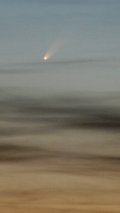
|
Thorsten Boeckel,
Bavaria, Germany
Jan. 7, 2007 |
#1,
#2, #3,
more |
The comet was
clear and bright to see with the naked eye as the sun set
at 16:20 UTC.
Photo
details: Canon
20D, 100 mm lens, ASA 100, 1sec.
|
|
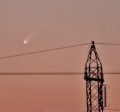
|
Peter
Naglic,
near Celje, Slovenia
Jan. 7, 2007 |
#1 |
Comet
McNaught (C/2006 P1) was visible to the naked eye. I took
this photo 17.13LT or 16.13UT.
Photo
details: Nikon
D70s, 300mm lens, f/5.6, IS0200, 2s exposure |
|

Note:
This photo is best
appreciated in full
size.
|
Mark
Vornhusen,
Schaffhausen, Switzerland
Jan. 7, 2007 |
#1 |
A
flying airplane and Comet McNaught in the evening sky!
Photo
details: Nikon
D70,180 mm lens, f2.8, ISO 200, 1/15s exposure |
|
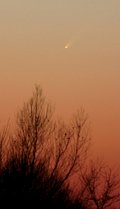
|
Gabor
Szendroi,
Kormend, Hungary
Jan. 7, 2007 |
#1 |
Photo details: Canon
EOS 300D, Zeiss sonnar 4/300, ISO 200, 2s exposure |
|
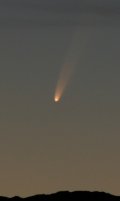
|
Roger
Johansen,
Hammerfest, Norway
Jan. 6, 2007 |
#1 |
Photo
details: Canon
EOS 30D, 300 mm lens, f/4, ISO 320, 2 second exposure |
|
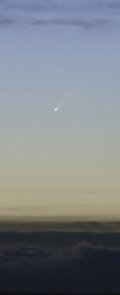
|
Alan
Dyer,
Near Cluny, southern Alberta, Canada
Jan. 6, 2007 |
#1 |
Here's
a shot of Comet McNaught (2006 P1) bright in the evening
twilight, easily visible in binoculars with a tail (as it
appears here) and visible to the naked eye to the right
of Venus. This was taken January 6. Its magnitude was about
-1. This was taken from a latitude of 50o N --
being farther north helps for viewing this comet as it tracks
north of the Sun as it passes thru perihelion.
Photo
details: Canon
20D, 200mm lens, f/2.8, ISO100. Exposure metered. |
|
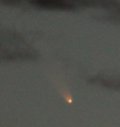
|
Alan
C Tough,
Elgin, Moray, Scotland
Jan. 7, 2007 |
#1,
|
This
image of Comet 2006 P1 (McNaught) was taken at 07:49 UT
on January 7, 2007.
Photo
details: Canon
EOS 300D, 300 mm lens, 1/6 second exposure @ f/5.6 and
ISO 800. |
|

|
Guillaume
Cannat,
Assas, near Montpellier, France
Jan. 6, 2007 |
#1,
#2, more |
Very
good and cold weather this morning. The comet was visible
with the naked eye 2o above the horizon a few
minutes after its rising and 50 minutes before the rising
sun.
Photo
details: image #1--Nikon
D70s, 180 mm lens, 2.8, 0.5 s, ISO 200; image #2--Nikon
D70s, 300 mm, 4.5, 6 x 0.5 s, ISO 200 |
|
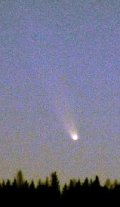
|
Haakon
Dahle,
Fjellhamar, Norway
Jan. 5, 2007 |
#1,
#2 |
The
picture was taken 06h40m UT, shortly after the comet rose
above the local horizon. The comet was then 3 degrees above
(and the sun 10 degrees below) the true horizon. The comet
was visible to the naked eye, and the tail was a beautiful
sight in binoculars.
Photo
details: Nikon
D70, 300mm f/5.6 lens, 800 ASA, 1s exp |
|
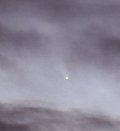
|
P-M
Heden,
Vallentuna, Sweden
Jan. 5, 2007 |
#1,
#2, more |
This
morning, I photographed Comet McNaught (C/2006 P1) through
a break in the clouds. I saw the comet with my naked eyes
before the sun made the sky too bright.
Photo
details: Canon
Digital Rebel XT, 75-300mm lens, f/5.6, iso 100 exposure
2s. |
|
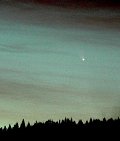
|
Haakon
Dahle,
Fjellhamar, Norway
Jan. 3, 2007 |
#1,
#2 |
The
comet was faintly visible to the naked eye before sunrise,
at an altitude of 4 degrees (the sun was 10 degrees below
the horizon). The photos resemble the view through binoculars.
Photo
details: Nikon
D70, 300mm lens, f/5.6, 800 ASA, 1s exposure. |
more
images: from
Vincent Jacques
near Menton, Alpes maritimes in the southeast of France (Jan.
6); from Alan C Tough
of Elgin, Moray, Scotland; from
Tony Scarmato of San
Costantino di Briatico, Calabria, Italy (Jan. 7). |
|